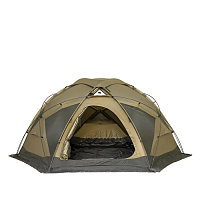Cart
How to Deal with Tent Condensation
Tent condensation is a common issue that campers often face during outdoor trips. It occurs when warm, humid air inside the tent comes into contact with the cooler tent walls, causing moisture to accumulate. Dealing with tent condensation is crucial to ensure a comfortable and dry camping experience. In this article, we will explore effective strategies and tips to manage and minimize tent condensation. By implementing these techniques, you can mitigate condensation-related problems and enjoy a more pleasant camping adventure.
1. Choose a Proper Campsite:
Selecting the right campsite can significantly impact your tent's condensation levels. Look for a location with good airflow and ventilation. Avoid low-lying areas or spots near bodies of water, as these tend to have higher humidity levels. Camping on higher ground or in areas with natural windbreaks can help improve air circulation and reduce condensation inside your tent.
2. Ventilate Your Tent:
Proper ventilation is key to reducing condensation buildup. Ensure your tent has sufficient vents and openings to allow air to circulate. Keep the tent's doors and windows partially open, especially during the day when the weather permits. This allows fresh air to enter the tent and helps prevent moisture from accumulating. If your tent has adjustable vents, position them to promote airflow while still maintaining protection from the elements.
3. Manage Interior Moisture:
Minimizing moisture inside your tent can help reduce condensation. When entering the tent after activities like cooking or swimming, shake off excess moisture and dry off as much as possible before entering. Avoid bringing wet clothing or gear inside the sleeping area, as they can contribute to higher humidity levels. Instead, store damp items in the vestibule or a designated area outside the tent.
At POMOLY Find the Best Camping Gear for You
4. Use a Rainfly Properly:
A rainfly is an essential component of your tent's weather protection system. Ensure you properly install the rainfly, as it helps prevent moisture from seeping into the tent. Keep the rainfly guy lines taut to maintain airflow between the rainfly and the tent body, which aids in reducing condensation. Additionally, consider using a rainfly with adjustable vents or windows, allowing you to regulate airflow while keeping rain out.
5. Utilize Tent Air Circulation Accessories:
Several accessories can help improve airflow and reduce condensation inside your tent. One option is a tent fan, which promotes air movement and helps maintain a drier environment. Battery-powered or rechargeable fans are lightweight and easy to use. Additionally, you can use gear lofts or mesh storage pockets to elevate items off the tent floor, further enhancing air circulation and preventing moisture buildup.
6. Consider Tent Material and Design:
Different tent materials and designs can affect condensation levels. Some tents are specifically designed to minimize condensation by incorporating breathable fabrics and advanced venting systems. Look for tents with mesh panels or windows that allow for increased airflow. When purchasing a tent, consider the climate and conditions you'll be camping in, and choose a model that suits your needs.
7. Monitor Weather Conditions:
Being aware of the weather conditions can help you anticipate and manage tent condensation. Pay attention to the humidity levels and temperature changes in the area where you're camping. Cooler nights or high humidity can increase the likelihood of condensation. Adjust your ventilation and airflow strategies accordingly to ensure a comfortable and dry interior.
8. Use Absorbent Materials:
To prevent condensation from coming into contact with your gear and sleeping area, use absorbent materials such as camping towels, microfiber cloths, or moisture-absorbing products like silica gel packets. Wipe down the interior walls of your tent in the morning to remove excess moisture. This will help keep your tent and belongings drier throughout your camping trip.
Conclusion:
- Contact Us
-

About Pomoly
Pomoly is a leading camping brand specializing in hot tents and tent stoves. We are camping life explorer, Follow Page / Join Group, let's make camping enjoyful together!
Working Hours
Mon-Fri, 09:00 - 17:00

- Company Info
- NEWS
- About us
- Pomoly Name
- Leave-No-Trace
- Contact Now
- Facebook Group
- YouTube Learning
- Product News
- Contact Us
- Topic Collections
- Policies & Terms
- Payment Policy
- Shipping Policy
- Return & Refund
- Privacy Policy
- Terms of Use
- Tax Policy
- Website Disclaimer
- Safety Disclaimer
- Warranty Policy
- Promotion Policy
- Pre-order Policy
- INTELLECTUAL PROPERTY RIGHTS
- Dealers Agreement And Terms
- Become Affiliate
- User Center
- Forget Password
- My Orders
- Tracking Order
- My Account
- Register
- Popular Searches
-
Tipi Tents Dome Tents Camping Tent Hammock Stove Camping Camping Pellet Stove Circle 6 Titanium Water TankDome X Locomotive 20 LEO 2 camping tent T-Brick 2.0 T1 2.0 tent stove Dweller wood stove Oroqen 2.0 Chimney Water Tank Lumberjack STOVEHUT Bromance 70 Tipi Pomoly Coupon Baker Oven Stove Titanium elbow Fire Pits Tent Stove titanium Stove Outdoor Pellet Stove
keebon pellet stove






